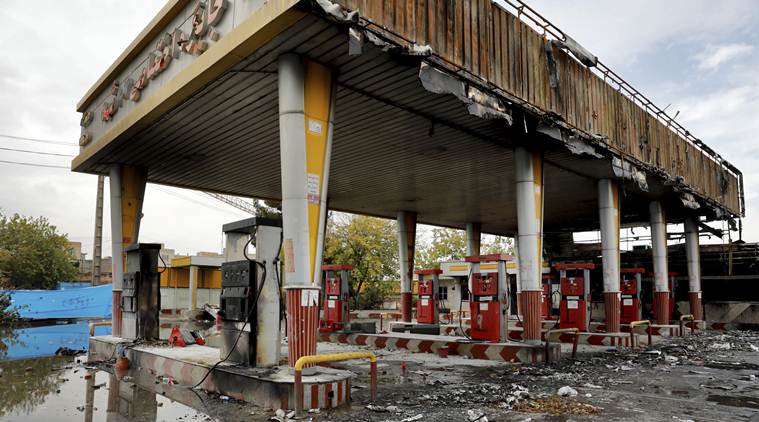Explained: Iran has so much oil, so why has the govt hiked prices?
Iran protests: In the four days starting November 15, between 180 and 450 people were killed, at least 2,000 were wounded, and some 7,000 detained, The NYT reported.
 A burnt bank building after protests in Tehran. (Reuters Photo)
A burnt bank building after protests in Tehran. (Reuters Photo)
Iran is passing through its deadliest unrest since the Islamic Revolution of 1979, with at least 180 people killed in a brutal crackdown by the state on protesters, western media outlets, including The New York Times, have reported.
The protests began in the middle of November, after the government sharply raised the price of petrol, and ordered strict rationing of the fuel.
Read this story in Tamil, Bangla
As people — mainly unemployed or poor young men in their 20s — poured out into the streets, security forces, including the elite Islamic Revolutionary Guards Corps, retaliated by firing on them.
As has been seen in neighbouring Lebanon and Iraq in recent weeks, the Iranian protests, though triggered initially by economic anxiety, rapidly took on a strong anti-government character.
In the four days starting November 15, between 180 and 450 people were killed, at least 2,000 were wounded, and some 7,000 detained, The NYT reported, quoting international human rights organisations, opposition groups, and dissident Iranian journalists.
So, why did Iran have to increase fuel prices?
Western media reports have interpreted President Hassan Rouhani’s new energy policy as a response to the country’s economic crisis, which has been worsened by United States sanctions, leading to sharply reduced exports of crude oil.
President Rouhani has been quoted as saying that Iran faces a deficit of upto two-thirds of its annual budget of $45 billion.
Iranian state television said the increase in prices was intended to help fund subsidies for about 60 million Iranians (almost 75% of the country’s population). Inflation in Iran is estimated by some analysts to be around 40 per cent.
While official media said the price increase was unrelated to the budget, The NYT quoted Maysam Sharifi, an oil and energy trader in Tehran, as saying the “treasury is empty and the only way they have to fill it is to take from the people’s pockets”.
 A demonstrator chants slogans while holding up an Iranian national flag during a pro-government rally in Tehran, Iran, denouncing violent protests over a government-imposed fuel price hike. (AP Photo: Ebrahim Noroozi)
A demonstrator chants slogans while holding up an Iranian national flag during a pro-government rally in Tehran, Iran, denouncing violent protests over a government-imposed fuel price hike. (AP Photo: Ebrahim Noroozi)
So, will the price increase help the economy?
Not really, feel most analysts.
While Iran has for long intended to slash energy subsidies as part of economic reforms — Rouhani’s predecessor Mahmoud Ahmadinejad had replaced subsidies with direct cash transfers — economists have said the new energy policy is not likely to succeed.
The reason is that while the price increases are not large enough to make a significant difference to overall government finances, ordinary Iranians would be hit hard.
“There will be no positive impact in the economy,” a report in NYT quoted Alireza Salavati, a political economist in London, as saying. “This policy is poorly planned and terribly executed and will result in more inflation and instability.”
 A gas station shows damages after it was attacked and burned during protests over rises in government-set gasoline prices, in Tehran, Iran, Wednesday, Nov. 20, 2019. (AP Photo: Ebrahim Noroozi)
A gas station shows damages after it was attacked and burned during protests over rises in government-set gasoline prices, in Tehran, Iran, Wednesday, Nov. 20, 2019. (AP Photo: Ebrahim Noroozi)
Is it odd that “oil-rich” Iran should see protests for this particular reason?
Automobile fuel has long been subsidised heavily in the country — resulting in a pattern of indiscriminate use, several analysts say.
What the government has now done is to raise the price of a litre of petrol from about 10,000 rials to about 15,000 rials — that is, from about Rs 17 to Rs 26.
It has also capped the monthly quota of fuel for a private car at 60 litres, beyond which fuel will cost 30,000 rials (or about Rs 51) per litre.
While these fuel prices would seem cheap to Indians, the increases came as a blow to Iranians long used to the heavily subsidised pricing regime. Iran has the world’s fourth-largest oil reserves, and second largest natural gas reserves.
Recently, President Rouhani announced the discovery of an enormous oil field holding 53 billion barrels of crude in southwestern Iran. If the reserves are confirmed, Iran will rise to the third position in the world.
Don’t miss from Explained: The Monarchy in Sweden, and the role of the King
- 01
- 02
- 03
- 04
- 05






































